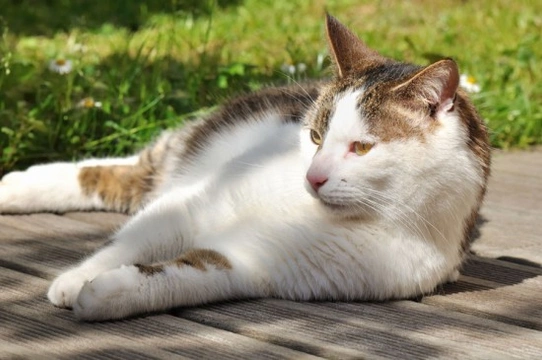
Cats, hot weather and heatstroke
Cats love to sit in a 'hot spot', whether it's indoors or in the garden, and are often seen basking in a patch of direct sunlight. They can usually cope with high temperatures better than dogs, but nevertheless they can become affected by heatstroke over a prolonged period, or at very high temperatures. It's not just hot weather that can affect cats either, as in winter they may well become overheated from sitting very close to a warm fire for too long indoors, or perching on a hot radiator, or even snoozing in the airing cupboard - and in cases like this they can become overheated and then not necessarily move as the effects of heatstroke get a grip. So keep an eye on your cats during those cold winter days too, and make sure that they are not getting too hot on the radiator!When the weather is hot, cats need somewhere cool to rest so that they are not overcome by heatstroke. If your cat goes out and heads for a sunny spot on the patio, it might be an idea to keep him in during the hottest part of the day, between 11am - 4pm. If your house tends to get very warm, perhaps it's worth considering getting some netting frames made to put over a back door or window, so that you can leave them open without danger of your cat escaping, or even having a ceiling fan fitted so that there is some air circulating without your cat going out. And make sure there's always some fresh cold water down for them to drink - like us, cats become thirstier in hot weather. If your cat likes wet food in jelly or gravy, don't leave this down during hot weather as it will attract flies and may cause a stomach upset or even food poisoning - it's better to feed little and often in this situation, taking the food away after your cat seems to have finished, rather than leaving it down when it will dry out and become very unappealing. Cats that do go out in the heat of the day, even if it's to sit in the confined safety of a netted run, are at risk of getting sunstroke. And if you keep a breeding stud cat outside in his own house and run, you will need to be especially careful that he does not become overheated - a fan situated away from his enquiring paws will help, as will one of those gel pads that you normally put in the microwave to heat up, except in this case put it in the freezer for a while so that he can have a cool bed. If you are leaving your cat at home whilst you are on holiday, with a friend or neighbour coming in to feed him twice a day, ensure that you make ample provision so that he doesn't suffer if the weather becomes very hot in your absence, and ensure that he doesn't have access to very hot radiators if you are going away for a winter holiday. Give your cat sitter very detailed guidelines on keeping the cat away from sources of direct sunlight, and maybe restrict access to where he can go so that he doesn't sit in a room that you know can become particularly hot. Cats with very pale coats, particularly those varieties with blue eyes, are also prone to getting sunburned ears which can be very painful for them. 'Pointed' cats such as Siamese, as well as other longhaired or shorthaired colourpoint varieties or Birmans, with pale coats and red, cream or apricot ears, tail, paws and face are particularly prone to sunburned ears, as are Cornish and Devon Rex cats with sparse fur, and of course, the hairless Sphynx. If they are going to sit outside at all, it's wise to spread some ordinary sun block cream on their ears. As in the case of humans, severely sunburned skin can also lead to a form of skin cancer, so it's well worth taking the precaution, and if lesions appear on the ears, these need immediate veterinary attention. If you need to travel with your cat in the car for a long distance when the weather is hot, perhaps to a cat show or going on holiday, make sure that he is shaded in the car for the journey. Try and avoid the 'perspex' type of cat carrier that will attract the sun, and choose a mesh one, or one with plenty of air holes so that they don't suffocate in the heat. And put a light covering over the top of the carrier to provide a bit of shade so that the cat is not sitting in direct sunlight. And needless to say, you should never leave a cat unattended in a stationary hot car, as, like dogs, they can quickly become very overheated and die. If, despite your best efforts, your cat does get heatstroke, you need to deal with it very quickly. Symptoms include heavy panting, a rapid heartbeat, drooling saliva, and the tongue and lips often become very red, later turning to a bluish tinge. Your cat will quickly become very weak and distressed, and he will have a high temperature, which, if it continues to rise will cause him to collapse and eventually go into a coma and then possibly die. Having removed the cat from the situation that has caused this problem, try and lower his temperature gently by applying a cold wet cloth to his skin, although you must be very careful not to lower it too far as it could actually cause hypothermia - just do this as a temporary measure whilst you arrange to rush your cat to the Vet as every minute will count towards his recovery.



